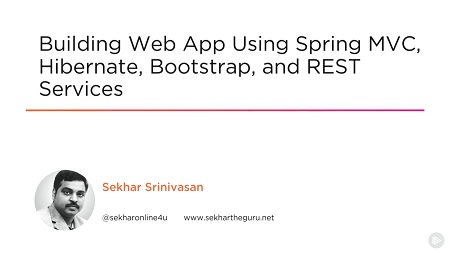
English | MP4 | AVC 1280×720 | AAC 44KHz 2ch | 7h 02m | 1.87 GB
This course is designed for beginners to understand how to Build Web App using Spring MVC, Hibernate, Spring Security, AOP, REST & Spring WebFlow. Upon completion, the viewer will be in a position to start developing a basic web app using Spring MVC.
This course is designed for beginners to understand how to Build Web App using Spring MVC, Hibernate, Spring Security, AOP, REST & Spring WebFlow. In this course, Building Web App using Spring MVC, Hibernate, Bootstrap, and REST Services, you will gain the ability to develop a web application using Spring MVC. First, you will learn how to work with Spring MVC. Next, you will discover how to perform CRUD operations using Hibernate. Finally, you will explore how to provide security for the application using Spring Security. When you’re finished with this course, you will have the skills and knowledge of Spring MVC, Hibernate, Bootstrap, Aspect Oriented Programming, Spring Security, REST Services, and Spring WebFlow needed to build a complete web application.
Table of Contents
Course Overview
1 Course Overview
Modifying the Front-end with Bootstrap
2 Introduction
3 Understanding Bootstrap 4 Grid System
4 Demo – Adding Bootstrap Support
5 Demo – Applying Bootstrap Grid System
6 Applying Styles for Spring Forms
7 Using Bootstrap Table Styles
8 Summary
Securing the Application
9 Introduction
10 Setting up Development Environment for Supporting Spring Security
11 Demo – Applying Spring Security Using HTTP-basic Authentication
12 Demo – HTTP-basic Authentication Using Properties File
13 Demo – Integrating Spring Security with Database
14 Demo – Spring Security Custom Login Form
15 Summary
Creating REST Services
16 Introduction
17 Understanding REST API
18 Creating REST API Using @ResponseBody
19 Creating REST API Using @RestController
20 Consuming REST API Service
21 Summary
Directing Users Based on Role with Spring Web Flow
22 Introduction
23 Understanding Spring Web Flow
24 Configuring Spring Web Flows
25 Elements of Spring Web Flow
26 Transitions and Flow Data Elements of Spring Web Flow
27 Demo – Creating a Web Flow
28 Demo – Adding Authentication Success Handler
29 Summary
Introduction to Spring Framework
30 What We Will Cover in This Course
31 Introduction to Spring Core Framework
32 Setting up Development Environment for Spring
33 Why Spring Inversion of Control
34 Spring Inversion of Control
35 Demo – Spring Inversion of Control
36 Spring Dependency Injection
37 Demo – Spring Dependency Injection Using Constructor
38 Demo – Spring Dependency Injection by Property
39 Auto Wiring
40 Demo – Auto Wiring
41 Spring Bean Scopes
42 Demo – Spring Bean Scopes
43 Spring Bean Life Cycle
44 Demo – Spring Bean Life Cycle
45 Understanding Spring Core Using Annotations
46 Demo – Understanding Spring Core Using Annotations
47 Summary
Configuring Your Environment for Spring MVC Application Development
48 Understanding Spring MVC Architecture
49 Spring MVC Configuration Overview
50 Demo – Spring MVC Configuration
51 Summary
Creating Controllers and Views
52 Introduction
53 Creating a Spring Controller and View
54 Demo – Creating a Spring Controller and View
55 Demo – Reading Form Data
56 Adding Data to the Spring Model
57 Demo – Adding Data to the Spring Model
58 Summary
Handling Spring Tags and Data Bindings
59 Introduction
60 Spring Form Tags Equivalent to HTML Tags
61 Demo – Using Spring Forms
62 Summary
Handling Request Parameters and Request Mappings
63 Introduction
64 Binding Request Parameters
65 Demo – Binding Request Parameters
66 Controller Level Request Mapping
67 Demo – Controller Level Request Mapping
68 Demo – @RequestMapping with Multiple URLs
69 Demo – @RequestMapping with @RequestParam
70 Demo – @RequestMapping with Dynamic URLs
71 Summary
Applying Built-in Validation Rules
72 Introduction
73 Spring MVC Form Validations Overview
74 Setting up Development Environment for Form Validations
75 Demo – Applying Validation Rules
76 Demo – Applying Validation Rules Size, Min, Max, Pattern, and Past
77 Pre-processing Code Validation Using @InitBinder
78 Creating Custom Validation Rules
79 Demo – Creating Custom Validation Rules
80 Summary
Performing CRUD Operations with Hibernate
81 Introduction
82 Overview of Hibernate
83 Setting up Development Environment for Supporting Hibernate Framework
84 Configuring Hibernate Properties Using XML File
85 Demo – Creating ORM Entity
86 Demo – Inserting a Record
87 Demo – Using HQL for Retrieving the Records
88 Demo – Updating the Record
89 Demo – Removing the Record
90 Summary
Managing Exceptions Through Aspect-oriented Programming
91 Introduction
92 Understanding AOP
93 Understanding AOP Terminology
94 Comparing Spring AOP and AspectJ
95 Setting up Development Environment for Supporting AOP
96 Demo – Aspect Oriented Programming
97 Demo – Managing Exceptions Using AOP
98 Summary
Resolve the captcha to access the links!